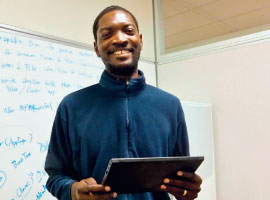Profile: Armah ’08 Helps Build Microsoft’s Consumer Cloud
 Quick adaptation and attention to detail are two skills that George Armah ’08 uses every day on the job.
Quick adaptation and attention to detail are two skills that George Armah ’08 uses every day on the job.
As a software engineer with Microsoft, Armah collaborated on building OneDrive synchronization technology, a part of the company’s file-hosting service that offers cloud storage and collaborative space for consumers. DropBox, Google Drive, and Apple’s iCloud are competitive offerings of a similar kind.
Armah writes code to verify expected functionality of the software. At the Redmond, Wash., office, he works with other engineers, product planners, and customer support specialists to design, verify, and make updates based on customer feedback.
“The most exciting and challenging aspect is that we are creating something that pleases millions of people,” Armah says. “Working at that scale is fun, and we have to constantly reevaluate not just what we do but how we are doing it to ensure that we can scale in an efficient manner.”
![]()
His work involves what he calls problem-finding and data-driven analysis of the software quality. “We model what the software looks like and how it behaves to find design gaps,” he says. “We also invest in technology that helps us understand how our product is being used by our customers.”
He worked as an EXCEL scholar with Rob Root, professor of mathematics, and Chun Wai Liew, associate professor of computer science, on a National Science Foundation study of how and why fish developed backbones, including creating mathematical models of swimming motion. He also traveled to Uganda with Rexford Ahene, professor of economics, to assist with the technology for a land-information system.
—Carrie Havranek